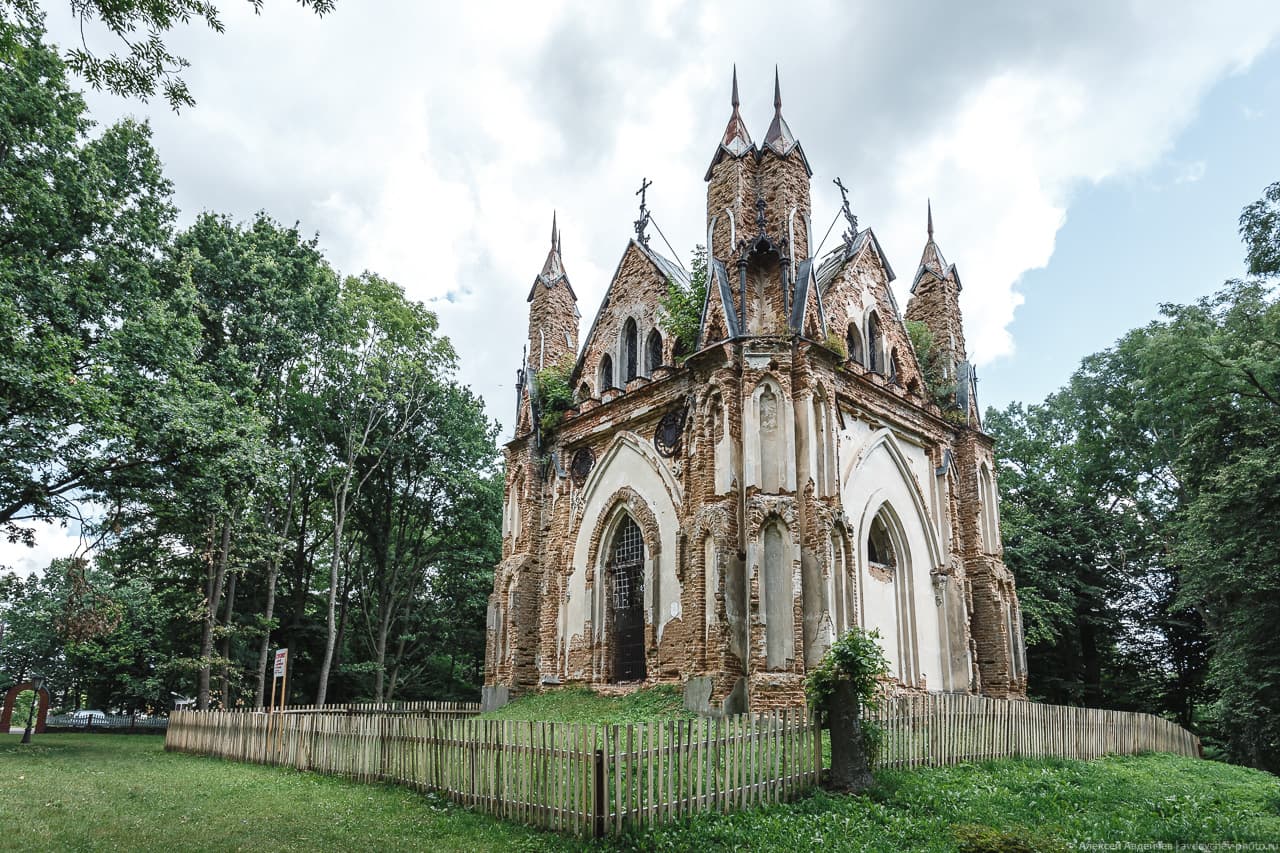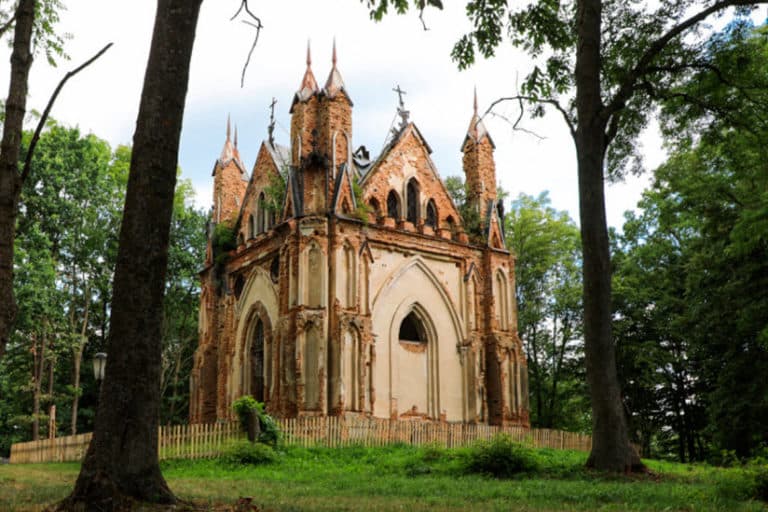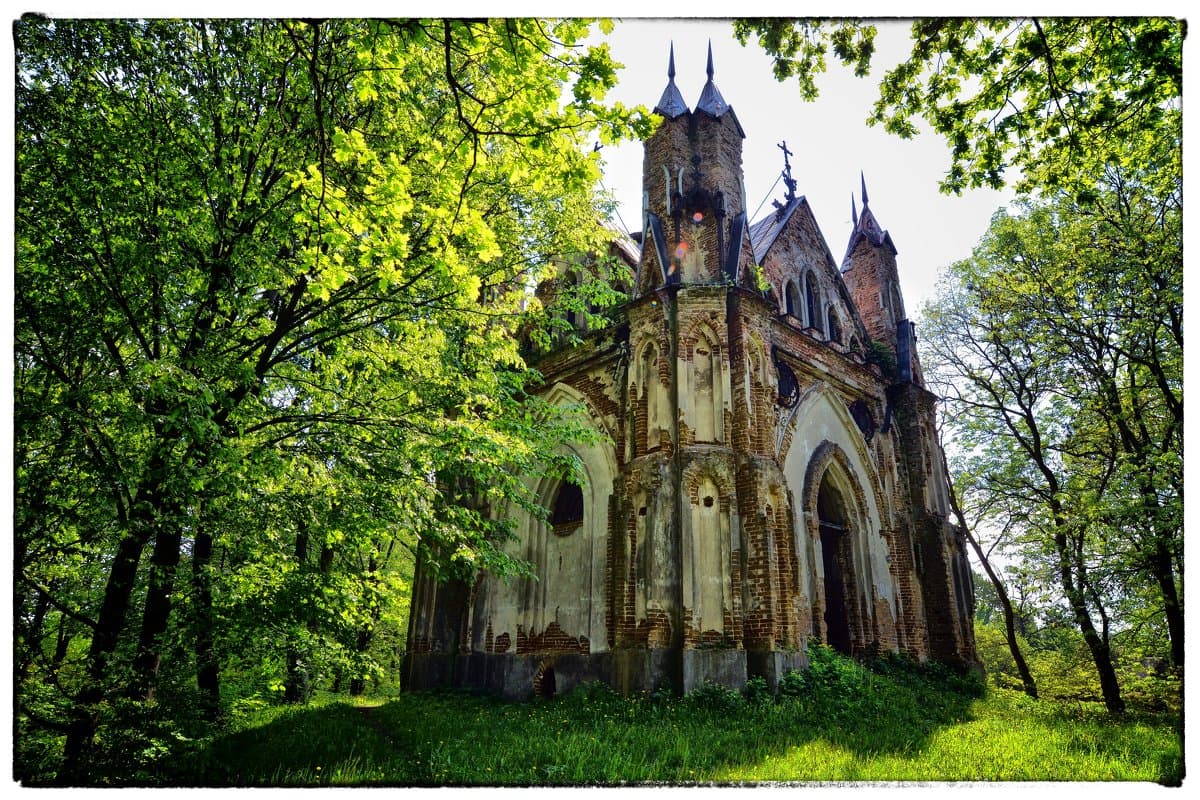Zakozel. Chapel-tomb of Ozheshko.
Landmark
Belarus, Brest region, Drogichinsky district, agricultural town Zakozel
Description
The Orzeszko chapel-tomb was built in 1849 in the neo-Gothic architectural style according to the design of the Polish architect Frantiszek Jaszczold (who built the Puslovsky Palace in Kossovo). The chapel is made of light red brick; in some places the roof has been preserved. The facades of the building are dissected by complex pointed and three-lobed arches-niches. The entrance is highlighted by a portal, and on both sides it is decorated with two massive cast-iron shields with the coats of arms of two branches of the famous Ozheshko family.
For a long time, the architectural monument of the 19th century was slowly destroyed under the influence of natural forces. Excavations helped uncover a large number of interior details, parts of statues, bronze castings, wooden and plaster sculptures, even a fragment of the Slutsk belt and much more - these artifacts can be seen in the Brest Regional Museum of Local Lore. Currently, restoration of the chapel-tomb is planned.
Categories
Ruins
On restoration
Historical
Architectural monument
Comments
Reviews to the Place
2Алег Дзьячкоу
21.01.2025
Zakozel. Ozheshko Manor.
In the Drogichin district there is a place called Zakozel, where the estate of the Ozheshko family is located. It was first mentioned in historical sources in the 13th century. At first it was the property of the king, and in the 18th century it passed to the Ozheshko family.
At that time, the town was part of the Brest voivodeship. During the time of the Russian Empire, it was the Kobrin district of the Grodno province.
At the beginning of the 19th century, a manor house with a palace was built in Zakozel. At first, Jozef Ozheshko was in charge here, then Nicodemus and Calixtus. A landscape park was planted. In 1839, a neo–Gothic chapel was built in the park. The estate was often visited by the famous Belarusian and Polish writer Eliza Ozheshko, who lived in the neighboring estate in Ludvinovo. The estate was visited by the famous artist Napoleon Orda, who left an image of a palace with a park.
During the anti–Russian uprising of 1863-1864, many of the Ozheshko family supported the uprising and were exiled.
In 1893, the Zakozel estate was sold to Countess Bobrinskaya. A brewery was built at her time, which has survived to our time, outbuildings and a renovated palace.
After the Riga Peace of 1921, Zakozel became part of the Polish state. Alexey Bobrinsky, the son of the Countess, sold the estate to Zygmunt Veselovsky in 1922. And Veselovsky resold it to another owner.
The palace was severely damaged during the Great Patriotic War and only the wing has survived to this day.
The park with water channels, the chapel–tomb and several outbuildings are in good condition.
С Н
20.06.2024
Zakozel. Chapel-tomb of Ozheshko.
Story
The chapel was built in 1849 according to the design of the Polish architect Francis Jaschold, with the consent of the Vilno bishop Andrzej Klongiewicz, on the outskirts of the park as the family tomb of Ozheshko and the following owners of the estate: Bobrinsky, Tollochko.
According to local legend, after the suppression of the uprising of 1863-1864, the leader of the Kobrin rebel detachment, Romuald Traugutt, took refuge in the high spire of the chapel, where there was a small storeroom. This refuge was offered to him by Elisa Ozheshko, who helped transport Romuald to Poland after the search gradually died down. It is worth noting that Eliza’s husband, Peter, was exiled to the Perm province for participating in the uprising.
The chapel was abolished in 1865 due to the fact that “the existence of the chapel has a bad influence on Zakozel’s many servants, and the isolation of the estate makes it difficult to supervise Polish propaganda.” However, with the permission of the Chief Head of the region, Mikhail Muravyev, it was transferred to the landowner Kalikst Ozheshko for transformation into a “gravestone monument” with the explanation: “since this chapel was not a parish and was the property of the owners of the estate, the property and the building must be returned to Ozheshko, however, so that the chapel is converted into a tomb with the destruction of the church domes on it and so that there would be no altar or any devices for worship left in the building"
In 1867, efforts were made to rebuild the temple into an Orthodox church according to the design of the architect Chekmasov, which was opposed by the surrounding nobility.
In 1915, during the First World War, the copper covering of the roof was removed. A new zinc roof was laid by the landowner Karol Tollochko, who bought the estate in 1923.
Architecture
An architectural monument of a retrospective-Gothic style. The central square structure is covered with acute-angled gable roofs, the intersection of which is marked by a high tetrahedral tent with a faceted spire and a Gothic cross at the end. The variegated silhouette and vertical orientation of the spatial composition are given by angular double pinnacles, between which sculptures of evangelists are placed in Gothic portals (cast iron).
The facades are richly dotted with buttresses grouped at the corners, tiered arrow-shaped and three-lobed niches. The arched entrance portal is decorated on top with round coats of arms of Ozheshko (artistic cast iron). The colorful richness of the building was created by high-quality “exposed” brickwork, copper roofing, and whitewashed decorative elements.
The hall is covered with a mirrored vault, rich in ornamentation from thin molded ribs. Sculptural images of the evangelists (not preserved) were located in the corner arched niches. Arched windows and dormer windows with geometric patterned sashes that were filled with colored stained glass. Under the chapel there is a crypt-tomb, where gatherings lead in the center of the hall.
Current state
At the moment, the chapel is gradually collapsing due to a lack of funding for its restoration or, at least, conservation. The external and internal plaster has almost completely collapsed, the stained glass windows have not been preserved, the ceilings and roof are in disrepair. Local authorities are making attempts to monitor the territory of the former park; the chapel itself is surrounded by a fence, the entrances are closed with bars. But the complete lack of funding does not allow stopping the rapid process of destruction of structures.
In 2008, archaeological excavations were carried out in and near the chapel, as a result of which the remains of representatives of the Ozheshko family, fragments of the Slutsk belt, human bones, bronze remains of coffins, and clothes of the dead were found. Archaeological finds aroused a certain interest in the condition of the monument, and design and estimate documentation for the restoration of the chapel was prepared. In November 2019, emergency work began at the site to prevent further destruction of the landmark. Restorers cleared the roof of debris, reduced the load on the vault and protected it from precipitation. In 2020, a six-meter spire was installed on the tomb chapel.



